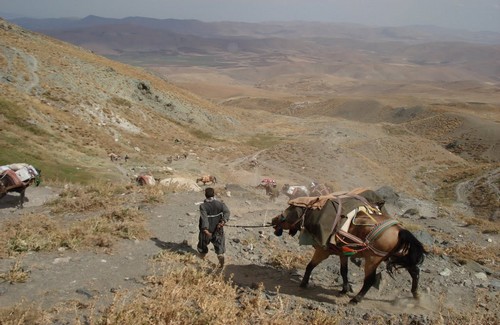Another Kurdish Courier Worker Killed in Shino
00:25 - 22 May 2015

Kurdpa: With the death of another Kurdish courier worker (kolbar) in Shino, the death and injury toll of cross-border couriers has reached nine, since the start of spring season which coincides with the start of new calendar year in Iran.
Kurdistan Press Agency has learned that following a pursuit of merchant couriers in the border areas of Shino in Eastern Kurdistan by Iranian border guards, on Tuesday 19 May, Qadir Shabro died, falling from a height while attempting to flee the attackers.
So far, Kurdpa has documented 65 deaths and injuries to individuals working as ‘kolbar’, couriers that carry goods on their backs across the border.
Kurdistan Media has confirmed Shabro’s death along with his home town of ‘Nalos’ in the suburbs of Shino city in Wurme (West Azarbijan) Province.
Kurdpa had also reported another tragic incident, where “Mohajer” a Kurdish courier from the suburbs of Wurme (West Azarbijan province) was injured in early morning of Thursday 14 May, as a result of direct shooting of Islamic Republic of Iran’s border security forces.
Lack of employment opportunities, government investment and adequate understating of economic conditions in the Kurdish areas has pushed many Kurds to engage in the dangerous and harsh labor of kolbari.
The neglected Kurdish areas of Iran are marked by a general dearth of economic infrastructure and development proportionate to the population, resulting in high rates of poverty and unemployment, the International Campaign for Human Rights in Iran reported in their 2012 report.
Masoud Kurdpour, now an imprisoned journalist, told Deutsche Welle news agency in an interview in April 2011: “You see all the individuals who are kolbar and who die for this. This phenomenon of working as a kolbar shows that the economic situation of the region is so bad that people are forced to take on a job that has a security component and carries the danger of death and being shot.”
The Iranian government puts the unemployment rate for the region at 14 percent, but local experts and activists say this number is a misrepresentation and the real rate is well over 20 percent, and even much higher among the younger population just entering the labor market.
Writing by Kurdpa Staff Writers and editing by Hazhir B.
Kurdistan Press Agency has learned that following a pursuit of merchant couriers in the border areas of Shino in Eastern Kurdistan by Iranian border guards, on Tuesday 19 May, Qadir Shabro died, falling from a height while attempting to flee the attackers.
So far, Kurdpa has documented 65 deaths and injuries to individuals working as ‘kolbar’, couriers that carry goods on their backs across the border.
Kurdistan Media has confirmed Shabro’s death along with his home town of ‘Nalos’ in the suburbs of Shino city in Wurme (West Azarbijan) Province.
Kurdpa had also reported another tragic incident, where “Mohajer” a Kurdish courier from the suburbs of Wurme (West Azarbijan province) was injured in early morning of Thursday 14 May, as a result of direct shooting of Islamic Republic of Iran’s border security forces.
Lack of employment opportunities, government investment and adequate understating of economic conditions in the Kurdish areas has pushed many Kurds to engage in the dangerous and harsh labor of kolbari.
The neglected Kurdish areas of Iran are marked by a general dearth of economic infrastructure and development proportionate to the population, resulting in high rates of poverty and unemployment, the International Campaign for Human Rights in Iran reported in their 2012 report.
Masoud Kurdpour, now an imprisoned journalist, told Deutsche Welle news agency in an interview in April 2011: “You see all the individuals who are kolbar and who die for this. This phenomenon of working as a kolbar shows that the economic situation of the region is so bad that people are forced to take on a job that has a security component and carries the danger of death and being shot.”
The Iranian government puts the unemployment rate for the region at 14 percent, but local experts and activists say this number is a misrepresentation and the real rate is well over 20 percent, and even much higher among the younger population just entering the labor market.
Writing by Kurdpa Staff Writers and editing by Hazhir B.



